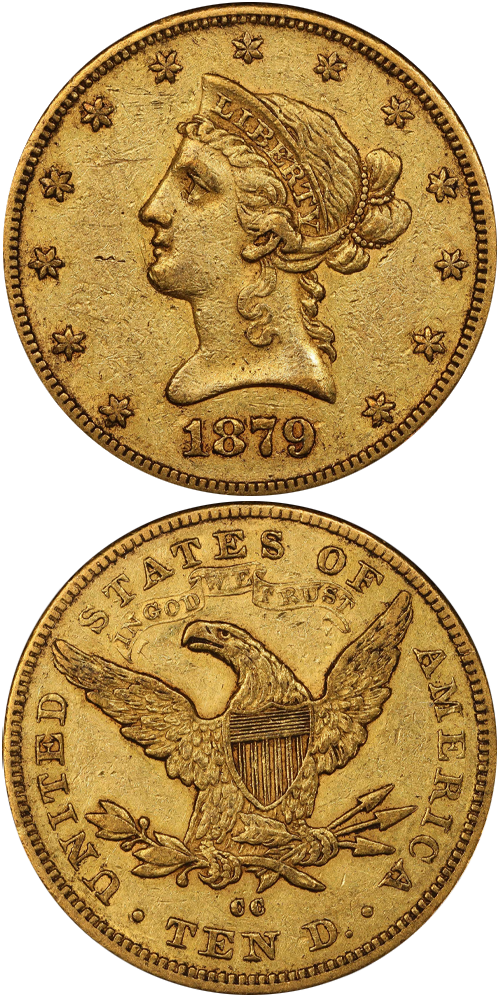1879-CC Liberty Head Eagle
Jeff Ambio: The date on the obverse of all known 1879-CC Liberty eagles is placed midway between the base of Liberty's neck and the denticles. Magnification reveals some fill within the loop of the 9. The reverse is the same as that used to strike all known 1878-CC eagles.
Rusty Goe: Mineral output from the Comstock Lode would fall in 1879 to one quarter of the previous year's yield. It spiraled downward from then on, with only a few exceptions where production would recover temporarily, but never to the stupendous levels seen in the mid-1870s. This did not bode well for the Carson City Mint.
Superintendent James Crawford went about his business as if there was nothing to fear. According to the Carson Morning Appeal of January 4, 1879, Crawford commissioned a crew to come in and give the mint's interior "a new coat of paint." Three months later, he suffered much anxiety when the Treasury Department, ordered him to suspend more than half of his payroll. The reason: a lack of bullion to keep the presses running.
The suspension lasted until August, at which time the coining department resumed operations. Because of the work stoppage coinage production was cut to a third of 1878's total. Gold coin yields took a major hit, as the aggregate face value of all three denominations sunk to the lowest level since the mint had opened in 1870.
In late 1879, the coining department turned out 1,762 gold eagles, the lowest mintage figure for and gold issue in the Carson Mint's history. This came at a time when the Philadelphia and San Francisco Mints had for six months, according to the Daily Alta of January 2, 1880, been "largely [increasing] coinage of Eagles and Half Eagles."
From the time it became widely known to collectors, the 1879-CC eagle's low mintage figure signaled that the Carson Mint had produced an instant rarity. The Carson City eagles from the 1870s, led by the 1870 and concluding with the equally rare 1879, offer a stimulating challenge to anyone seeking to acquire them.
Q. David Bowers: Rusty Goe estimates 70 to 85 1879-CC eagles survive, with just one Uncirculated. In 2003 the highest graded certified coins or events were one AU-58 by PCGS, and three at the same level by NGC. I am much more conservative and estimate 30 to 45. VF is the typical grade seen. A rarity of formidable proportions, in about the same league as the more famous 1870-CC. A key to the eagle series.
What cataloger Norman Stack said in our sale of the Samuel W. Wolfson Collection 50 years ago in 1962 is 100 percent appropriate:
1879-CC Extremely Fine. Only faint traces of having been in circulation. Far above average for this coin, since the few available specimens ever offered are always in the lower grades, near Very Fine. This is the rarest coin of the Carson City Mint, as only 1,762 were struck. We cannot state specifically how many are still available, but we can assure you it is a small number. However, this is one of the very few specimens that have ever passed through our hands. Many of the great collections offered in the last decade did not have this date and mint.... It may be many years before another opportunity presents itself to acquire this rare coin.
The example to the left was sold by Stack's Bowers Galleries in the Fairmont Collection, Hendricks Set, where it realized $43,200.






